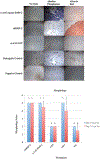Genetic modification of scAAV-equine-BMP-2 transduced bone-marrow-derived mesenchymal stem cells before and after cryopreservation: An "off-the-shelf" option for fracture repair
- PMID: 30578639
- PMCID: PMC8366205
- DOI: 10.1002/jor.24209
Genetic modification of scAAV-equine-BMP-2 transduced bone-marrow-derived mesenchymal stem cells before and after cryopreservation: An "off-the-shelf" option for fracture repair
Abstract
Optimizing the environment of complex bone healing and improving treatment of catastrophic bone fractures and segmental bone defects remains an unmet clinical need both human and equine veterinary medical orthopaedics. The objective of this study was to determine whether scAAV-equine-BMP-2 transduced cells would induce osteogenesis in equine bone marrow derived mesenchymal stem cells (BMDMSCs) in vitro, and if these cells could be cryopreserved in an effort to osteogenically prime them as an "off-the-shelf" gene therapeutic approach for fracture repair. Our study found that transgene expression is altered by cell expansion, as would be expected by a transduction resulting in episomal transgene expression, and that osteoinductive levels could still be achieved 5 days after recovery, and protein expression would continue up to 14 days after transduction. This is the first evidence that cryopreservation of genetically modified BMDMSCs would not alter the osteoinductive potential or clinical use of allogeneic donor cells in cases of equine fracture repair. © 2018 Orthopaedic Research Society. Published by Wiley Periodicals, Inc. J Orthop Res 37:1310-1317, 2019.
Keywords: bone biology; bone fracture; bone repair; progenitors and stem cells; therapeutics.
© 2018 Orthopaedic Research Society. Published by Wiley Periodicals, Inc.
Figures





Similar articles
-
Gene Therapy for Bone Repair Using Human Cells: Superior Osteogenic Potential of Bone Morphogenetic Protein 2-Transduced Mesenchymal Stem Cells Derived from Adipose Tissue Compared to Bone Marrow.Hum Gene Ther. 2018 Apr;29(4):507-519. doi: 10.1089/hum.2017.097. Epub 2018 Mar 14. Hum Gene Ther. 2018. PMID: 29212377 Free PMC article.
-
Can Extracorporeal Shockwave Promote Osteogenesis of Equine Bone Marrow-Derived Mesenchymal Stem Cells In Vitro?.Stem Cells Dev. 2020 Jan 15;29(2):110-118. doi: 10.1089/scd.2019.0202. Epub 2019 Dec 17. Stem Cells Dev. 2020. PMID: 31744386
-
Lentiviral Gene Therapy for Bone Repair Using Human Umbilical Cord Blood-Derived Mesenchymal Stem Cells.Hum Gene Ther. 2019 Jul;30(7):906-917. doi: 10.1089/hum.2018.054. Epub 2019 Apr 22. Hum Gene Ther. 2019. PMID: 30773946 Free PMC article.
-
HORSE SPECIES SYMPOSIUM: Use of mesenchymal stem cells in fracture repair in horses.J Anim Sci. 2015 Mar;93(3):871-8. doi: 10.2527/jas.2014-8516. J Anim Sci. 2015. PMID: 26020865 Review.
-
The challenges of promoting osteogenesis in segmental bone defects and osteoporosis.J Orthop Res. 2018 Jun;36(6):1559-1572. doi: 10.1002/jor.23845. Epub 2018 Mar 6. J Orthop Res. 2018. PMID: 29280510 Free PMC article. Review.
Cited by
-
Insights into the bone morphogenetic protein signaling in musculoskeletal disorders: Mechanisms and crosstalk.J Orthop Translat. 2025 May 16;52:419-440. doi: 10.1016/j.jot.2025.03.005. eCollection 2025 May. J Orthop Translat. 2025. PMID: 40485850 Free PMC article. Review.
-
Regenerative Medicine for Equine Musculoskeletal Diseases.Animals (Basel). 2021 Jan 19;11(1):234. doi: 10.3390/ani11010234. Animals (Basel). 2021. PMID: 33477808 Free PMC article. Review.
-
Women's contribution to stem cell research for osteoarthritis: an opinion paper.Front Cell Dev Biol. 2023 Dec 19;11:1209047. doi: 10.3389/fcell.2023.1209047. eCollection 2023. Front Cell Dev Biol. 2023. PMID: 38174070 Free PMC article. Review. No abstract available.
-
Clinical Application of Bone Marrow Mesenchymal Stem/Stromal Cells to Repair Skeletal Tissue.Int J Mol Sci. 2020 Dec 21;21(24):9759. doi: 10.3390/ijms21249759. Int J Mol Sci. 2020. PMID: 33371306 Free PMC article. Review.
-
Application of BMP in Bone Tissue Engineering.Front Bioeng Biotechnol. 2022 Mar 31;10:810880. doi: 10.3389/fbioe.2022.810880. eCollection 2022. Front Bioeng Biotechnol. 2022. PMID: 35433652 Free PMC article. Review.
References
-
- Ahern BJ, Richardson DW, Boston RC, et al.2010. Orthopedic infections in equine long bone fractures and arthrodeses treated by internal fixation: 192 cases (1990–2006). Vet Surg 39:588–593. - PubMed
-
- Luu HH, Song WX, Luo X, et al.2007. Distinct roles of bone morphogenetic proteins in osteogenic differentiation of mesenchymal stem cells. J Orthop Res 25:665–677. - PubMed
-
- Wei S, Cai X, Huang J, et al.2012. Recombinant human BMP-2 for the treatment of open tibial fractures. Orthopedics 35:e847–e854. - PubMed
-
- Seo JP, Tsuzuki N, Haneda S, et al.2014. Osteoinductivity of gelatin/beta-tricalcium phosphate sponges loaded with different concentrations of mesenchymal stem cells and bone morphogenetic protein-2 in an equine bone defect model. Vet Res Commun 38:73–80. - PubMed
Publication types
MeSH terms
Substances
Grants and funding
LinkOut - more resources
Full Text Sources
Medical

